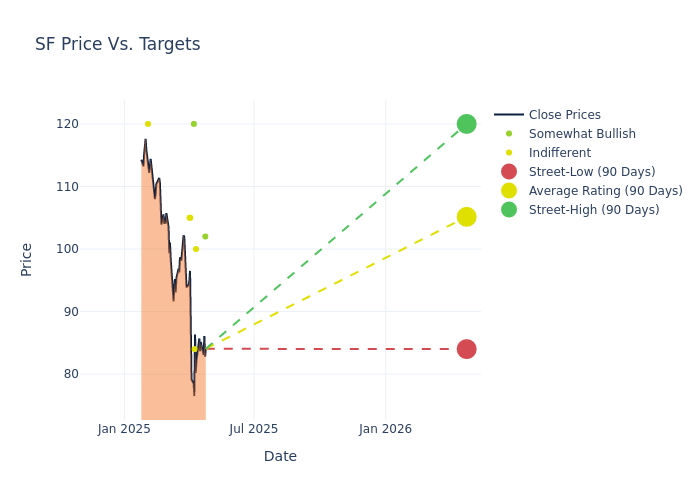What Analysts Are Saying About Stifel Financial Stock
Stifel Financial (NYSE:SF) underwent analysis by 10 analysts in the last quarter, revealing a spectrum of viewpoints from bullish to bearish.
The following table summarizes their recent ratings, shedding light on the changing sentiments within the past 30 days and comparing them to the preceding months.
| Bullish | Somewhat Bullish | Indifferent | Somewhat Bearish | Bearish | |
|---|---|---|---|---|---|
| Total Ratings | 0 | 5 | 5 | 0 | 0 |
| Last 30D | 0 | 1 | 0 | 0 | 0 |
| 1M Ago | 0 | 2 | 4 | 0 | 0 |
| 2M Ago | 0 | 0 | 0 | 0 | 0 |
| 3M Ago | 0 | 2 | 1 | 0 | 0 |
In the assessment of 12-month price targets, analysts unveil insights for Stifel Financial, presenting an average target of $111.2, a high estimate of $135.00, and a low estimate of $84.00. A 10.18% drop is evident in the current average compared to the previous average price target of $123.80.

Diving into Analyst Ratings: An In-Depth Exploration
A clear picture of Stifel Financial's perception among financial experts is painted with a thorough analysis of recent analyst actions. The summary below outlines key analysts, their recent evaluations, and adjustments to ratings and price targets.
| Analyst | Analyst Firm | Action Taken | Rating |Current Price Target| Prior Price Target | |--------------------|--------------------|---------------|-----------------|--------------------|--------------------| |Michael Brown |Wells Fargo |Lowers |Overweight | $102.00|$106.00 | |Michael Cho |JP Morgan |Lowers |Neutral | $100.00|$123.00 | |Bill Katz |TD Cowen |Lowers |Hold | $84.00|$124.00 | |Michael Brown |Wells Fargo |Lowers |Overweight | $106.00|$135.00 | |Devin Ryan |JMP Securities |Lowers |Market Outperform| $120.00|$135.00 | |Alexander Blostein |Goldman Sachs |Lowers |Neutral | $105.00|$121.00 | |Christopher Allen |Citigroup |Lowers |Neutral | $105.00|$125.00 | |Brennan Hawken |UBS |Raises |Neutral | $120.00|$116.00 | |Devin Ryan |JMP Securities |Raises |Market Outperform| $135.00|$125.00 | |Michael Brown |Wells Fargo |Raises |Overweight | $135.00|$128.00 |
Key Insights:
- Action Taken: Analysts frequently update their recommendations based on evolving market conditions and company performance. Whether they 'Maintain', 'Raise' or 'Lower' their stance, it reflects their reaction to recent developments related to Stifel Financial. This information provides a snapshot of how analysts perceive the current state of the company.
- Rating: Analysts unravel qualitative evaluations for stocks, ranging from 'Outperform' to 'Underperform'. These ratings offer insights into expectations for the relative performance of Stifel Financial compared to the broader market.
- Price Targets: Analysts set price targets as an estimate of a stock's future value. Comparing the current and prior price targets provides insight into how analysts' expectations have changed over time. This information can be valuable for investors seeking to understand consensus views on the stock's potential future performance.
Considering these analyst evaluations in conjunction with other financial indicators can offer a comprehensive understanding of Stifel Financial's market position. Stay informed and make well-informed decisions with our Ratings Table.
Stay up to date on Stifel Financial analyst ratings.
Get to Know Stifel Financial Better
Stifel Financial is a middle-market-focused investment bank that produces more than 90% of its revenue in the United States. Approximately 67% of the company's net revenue is derived from its global wealth management division, which supports over 2,000 financial advisors, with the remainder coming from its institutional securities business. Stifel has a history of being an active acquirer of other financial-services firms.
Financial Milestones: Stifel Financial's Journey
Market Capitalization Analysis: The company exhibits a lower market capitalization profile, positioning itself below industry averages. This suggests a smaller scale relative to peers.
Revenue Growth: Stifel Financial's revenue growth over a period of 3M has been noteworthy. As of 31 December, 2024, the company achieved a revenue growth rate of approximately 19.21%. This indicates a substantial increase in the company's top-line earnings. When compared to others in the Financials sector, the company faces challenges, achieving a growth rate lower than the average among peers.
Net Margin: Stifel Financial's net margin lags behind industry averages, suggesting challenges in maintaining strong profitability. With a net margin of 17.41%, the company may face hurdles in effective cost management.
Return on Equity (ROE): Stifel Financial's ROE falls below industry averages, indicating challenges in efficiently using equity capital. With an ROE of 4.75%, the company may face hurdles in generating optimal returns for shareholders.
Return on Assets (ROA): The company's ROA is below industry benchmarks, signaling potential difficulties in efficiently utilizing assets. With an ROA of 0.6%, the company may need to address challenges in generating satisfactory returns from its assets.
Debt Management: Stifel Financial's debt-to-equity ratio is below the industry average. With a ratio of 0.31, the company relies less on debt financing, maintaining a healthier balance between debt and equity, which can be viewed positively by investors.
Analyst Ratings: What Are They?
Ratings come from analysts, or specialists within banking and financial systems that report for specific stocks or defined sectors (typically once per quarter for each stock). Analysts usually derive their information from company conference calls and meetings, financial statements, and conversations with important insiders to reach their decisions.
In addition to their assessments, some analysts extend their insights by offering predictions for key metrics such as earnings, revenue, and growth estimates. This supplementary information provides further guidance for traders. It is crucial to recognize that, despite their specialization, analysts are human and can only provide forecasts based on their beliefs.
Breaking: Wall Street's Next Big Mover
Benzinga's #1 analyst just identified a stock poised for explosive growth. This under-the-radar company could surge 200%+ as major market shifts unfold. Click here for urgent details.
This article was generated by Benzinga's automated content engine and reviewed by an editor.
 Wall Street Journal
Wall Street Journal